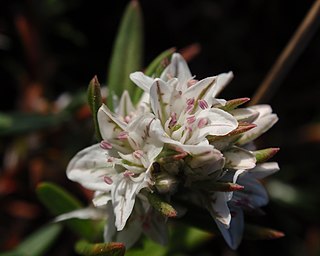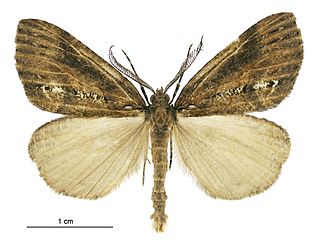
Hawaii is an island state in the Western United States, about 2,000 miles (3,200 km) from the U.S. mainland in the Pacific Ocean. It is the only U.S. state outside North America, the only one which is an archipelago, and the only one in the tropics.

The Polygonaceae are a family of flowering plants known informally as the knotweed family or smartweed—buckwheat family in the United States. The name is based on the genus Polygonum, and was first used by Antoine Laurent de Jussieu in 1789 in his book, Genera Plantarum. The name may refer to the many swollen nodes the stems of some species have, being derived from Greek [poly meaning 'many' and gony meaning 'knee' or 'joint']. Alternatively, it may have a different origin, meaning 'many seeds'.

Nicotiana is a genus of herbaceous plants and shrubs in the family Solanaceae, that is indigenous to the Americas, Australia, Southwestern Africa and the South Pacific. Various Nicotiana species, commonly referred to as tobacco plants, are cultivated as ornamental garden plants. N. tabacum is grown worldwide for the cultivation of tobacco leaves used for manufacturing and producing tobacco products, including cigars, cigarillos, cigarettes, chewing tobacco, dipping tobacco, snuff, and snus.

The poplar grey is a moth of the family Noctuidae. It is found throughout Europe.

Hypena rostralis, the buttoned snout, is a moth of the family Erebidae. It is found in Europe far into Scandinavia.Then through the Palearctic into Asia Minor, the Caucasus and east to Siberia. It is widespread at forest edges, forest clearings, shore areas, in gardens, park landscapes and cultivated land and rises in the mountains up to 1600 m.
Micragrella is a genus of moths in the subfamily Arctiinae. The genus was erected by Watson in 1980.

Lineodes is a genus of snout moths of the subfamily Spilomelinae in the family Crambidae. The genus was described by Achille Guenée in 1854, with Lineodes hieroglyphalis as the type species.

Phalacra is a genus of moths belonging to the subfamily Drepaninae. The genus was erected by Francis Walker in 1866.

Polygonum paronychia is a species of flowering plant in the knotweed family known by the common names dune knotweed, black knotweed, and beach knotweed. It is native to the coastline of western North America from British Columbia to California, where it grows in sandy coastal habitat such as beaches, dunes, and scrub.

Coleophora ochrea is a moth of the family Coleophoridae found in Europe. It was first described by Adrian Hardy Haworth in 1828.
Mylothris ochrea is a butterfly in the family Pieridae. It is found in the Democratic Republic of the Congo. The habitat consists of forests and forest margins.

Triplaris americana is a species of flowering plant in the knotweed family known by many common names, including ant tree or pau-formiga, guacamayo, guayabo zancón, hormiguero, palo de Santa María, tachí, vara santa, pau-de-novato, formigueiro, taxizeiro, and devil tree. It is native to Central and South America, occurring from Panama to Brazil. It is also cultivated as an ornamental for its showy pink flowers.
Liptena ochrea is a butterfly in the family Lycaenidae. It is found in Cameroon and the Republic of the Congo.
Scopula ochrea is a moth of the family Geometridae. It is found in Yemen and Oman.

Chalastra ochrea is a moth of the family Geometridae. It is endemic to New Zealand. It has been observed in both the North and South Islands and inhabits native forest. Larvae of C. ochrea feed on the leaves of species in the genus Sophora including Sophora chathamica. Adults are on the wing from February until April. They have been collected via sugar traps.

Lineodes integra, the eggplant leafroller moth or nightshade leaftier, is a moth of the family Crambidae. It is found from the southern United States, south to Chile. It has also been recorded from Illinois, Michigan, Ontario and Cuba.

Lineodes fontella, the eastern lineodes moth, is a moth in the family Crambidae. It was described by Walsingham in 1913. It is found in the United States, where it has been recorded from Florida, North Carolina, South Carolina and Texas. Outside of the States, it is found in Jamaica, Cuba, the Dominican Republic, Mexico, Panama, Guatemala, Honduras, Brazil, French Guiana and Guyana.
Lineodes triangulalis is a moth in the family Crambidae. It was described by Heinrich Benno Möschler in 1890. It is found in Cuba, Puerto Rico, Jamaica, Dominica, the Bahamas, Mexico, Honduras, Guatemala, Colombia, Trinidad and Venezuela. In the United States it has been recorded from Florida and Texas.

Persicaria orientalis is a species of flowering plant in the family Polygonaceae, known as kiss-me-over-the-garden-gate and princess-feather. It was first described, as Polygonum orientale, by Carl Linnaeus in 1753. It was transferred to the genus Persicaria by Édouard Spach in 1841. Its native distribution is unclear. As of April 2023, Kew’s Plants of The World Online lists it’s native distribution as ranging from the Russian far east to Indochina, Malesia and Australia. It is widely cultivated and naturalized.











